#María Montez la Reina del tecnicolor
Text
Los Orígenes de la família Gracia
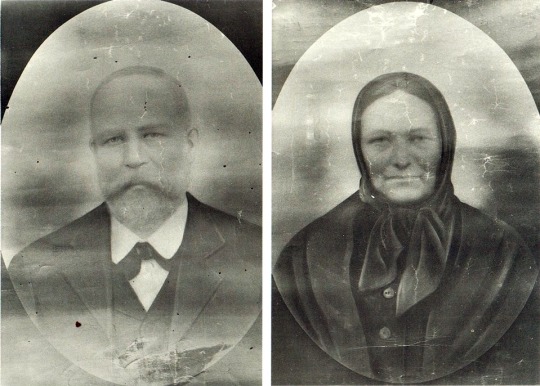
[Joaquín Gracia Anadón y María Antónia García Martín bisabuelos de Tina Aumont]
Joaquín Gracia Anadón - bisabuelo de Tina Aumont por parte de madre -, nació el 23 de mayo de 1841 en el municipio de Estercuel (Teruel), hijo de Pablo Gracia González, de la misma naturaleza, y de Tomasa Anadón Andrés, nacida en La Mata de los Olmos (Teruel). Sus abuelos paternos fueron Pedro Pablo Gracia y Ramona González, los maternos, Joaquín y María Teresa Andrés. Era bisnieto de Francisco Gracia e Isabel Ana Luño y de Francisco Anadón e Isabel Julve. Tomasa Anadón Andrés murió en Muniesa (Teruel) el 8 de mayo de 1867.
María Antonia García Martín - bisabuela de Tina Aumont por parte de madre -, nació en Garafía (La Palma), el 28 de septiembre de 1842. Era hija de Francisco Agustín García Medina y de María Antonia Martín Sánchez.
Cuando Joaquín Gracia Anadón tenía quince meses falleció su padre y junto a su madre se trasladó a casa de unos tíos en La Mata de los Olmos (Teruel), donde vivió durante su infancia y juventud. A la edad de 21 años fue llamado a filas e ingresa en el Batallón de Alcaníz. Más tarde fue enviado a la guerra de la isla de Santo Domingo y, terminada esta pasó a la isla de Cuba.
En Cuba conoció a María Antonia García Martín, que era natural de Garafía (las Palmas), ella era la mujer que sería su esposa.
Ambos contrajeron matrimonio, en la Iglesia de Nuestra Señora de la Luz de Garafía, el 17 de junio de 1872, inscrito en el Registro Civil del mismo municipio el 22 de abril de 1875. Establecieron el domicilio familiar en la Lomada de Santo Domingo, en el municipio de Garafia, lugar donde aún hoy se conserva la vivienda familiar.
El matrimonio del aragonés y la canaria tuvo seis hijos:
1. Isidoro, nacido el 3 de abril de 1873
2. Aquilino, nacido el 3 de enero de 1875
3. Tomasa, nacida el 31 de diciembre de 1876
4. Joaquín, nacido el 9 de mayo de 1878
5. Gaudencia, nacida el 12 de febrero de 1882
6. Agustín, que falleció menor
María Antonia García Martín, murió en Garafía el 21 de marzo de 1904, a los 61 años.
Joaquín Gracia Anadón, murió en Garafía, el 28 de febrero de 1913, a los 72 años de edad, de hemorragia cerebral.
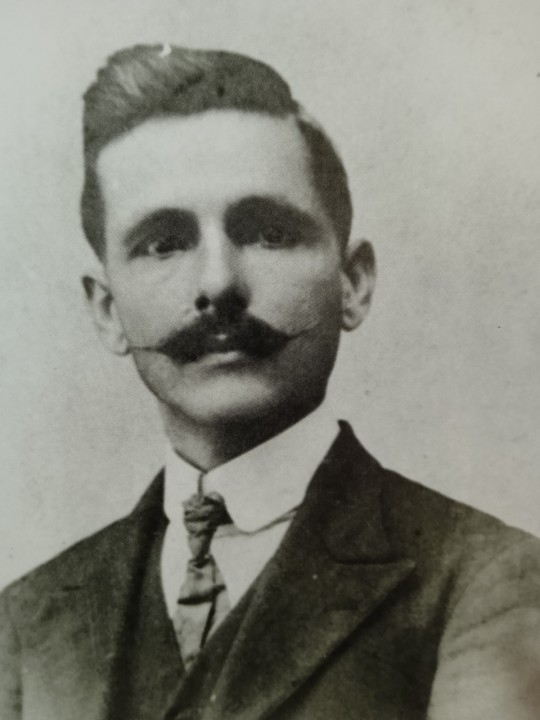
[Isidoro Gracia García, abuelo materno de Tina Aumont, fotografiado en su juventud]
Isidoro Gracia García nace en Garafía el 3 de abril de 1873, hijo de Joaquín Gracia Anadón, natural de Estercuel (Teruel), y de María Antonia García Martín, natural de Garafía, en la isla de La Palma.
Cuando Isidoro sólamente tenía diez años de edad fue sometido a un interrogatorio judicial, respecto del incendio de la Casa Consistorial de Garafía, cuyos cargos habían sido imputados a su padre. Este hecho, debió marcar de por vida a Isidoro Gracia García.
Las dificultades económicas de la familia obligaron a Isidoro y a su hermano Joaquín a emigrar en busca de fortuna, primero a Cuba y posteriormente a la República Dominicana, donde fijaron su residencia en la localidad de Barahona alrederores de 1904.
Isidoro se estableció como «comerciante de mucho crédito». Se dedicó a los prósperos negocios del textil y a la exportación de madera guayacán (Lignum vitae).
Su capacidad empresarial y sus facultades humanas le valieron el nombramiento por el entonces ministro de Estado (hoy, ministro de Asuntos Exteriores) como vicecónsul honorario, previa solicitud del Real Consulado de España en el país.
En Barahona fue donde Isidoro conoció a la que se convertiría en su compañera y, tras casi 16 años de convivencia, en su esposa, María Teresa Vidal Recio. Fruto de esta unión nacieron diez hijos. Isidoro y María Teresa contrayeron matrimonio el 7 de enero de 1925, para entonces ya habían nacido la mayoría de sus hijos. La segunda de estos fue María África Gracia Vidal, más conocida como María Montez en la gran pantalla, y los dos últimos vendrían después: Jaime, en 1927, y Teresa, en 1930.
A parte de esta numerosa descendencia, Isidoro tuvo otros dos hijos extramatrimoniales (Orbito y Gaudencio), y acogió a Antonio López (Toño), huérfano de un gran amigo. Se trataba así, de una gran familia.
Isidoro Gracia García fallece en Barahona en 1933.
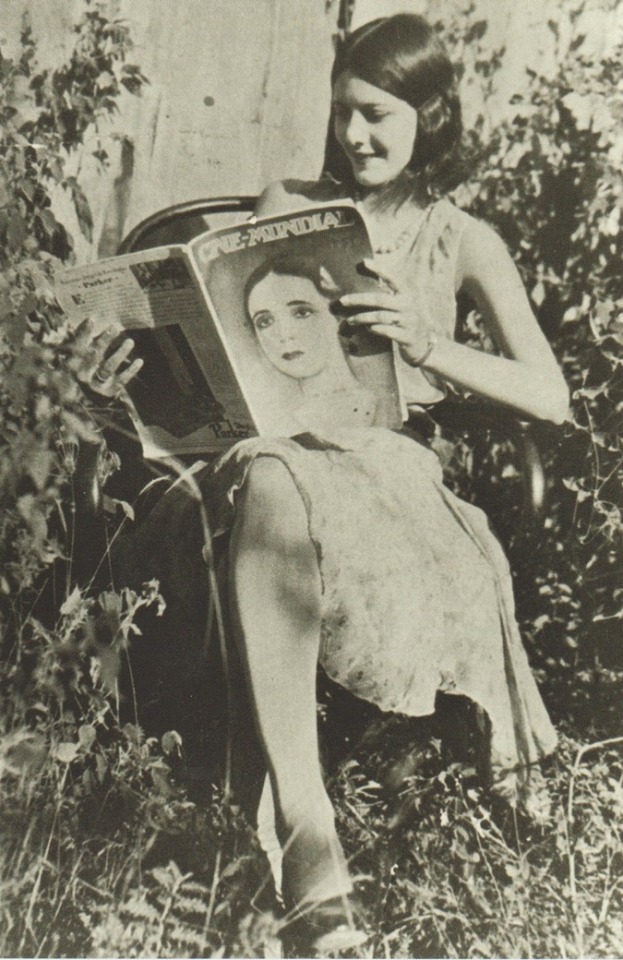
[María África Gracia Vidal fotografiada en 1930 antes de dar su salto a la fama]
A la orilla del mar Caribe, en Barahona (República Dominicana), nació, el 6 de junio de 1912, María África Gracia Vidal, hija del canario Isidoro Gracia García y de Teresa María Vidal, natural de Baní. Según sus biógrafos dominicanos, su nombre de pila fue deseo de su padre «en homenaje a su tierra natal, la Isla de la Palma (una de las Islas Canarias), que aunque pertenezca a España está localizada en el continente africano».
María fue la segunda de once hermanos: Isidoro, María África, Aquilino, Joaquín, David, Ada, Consuelo, Luz, Luis, Jaime y Teresita.
Desde pequeña, la futura actriz mostró interés por el teatro y el cine. Llegó a escribir pequeñas obras dramáticas que representaba ante sus amigos y familia. Aprendió inglés sin profesor alguno, contando sólo con asiduas lecturas en revistas y periódicos. Aún con estudios básicos, se atrevió con la publicación de tres libros y varios poemas sueltos, que firmaba con su verdadero nombre, María África Gracia.
Durante su vida María Montez mantuvo correspondencia con su primo Armando Gracia San Fiel (1913-1997) que residía en Madrid; las cartas muestran la personalidad sencilla de la actriz, próxima, comunicativa y curiosa por sus familiares palmeros coincidiendo con el momento en que ya se encontraba en la cumbre de su carrera cinematográfica.
La estrella también tuvo siempre presentes sus raíces aragonesas. En una carta de 1944 a su primo residente en Madrid, María contempla como posibles destinos para darle un hogar confortable a su madre "Barcelona o Teruel". En otro documento, afirma que está "muerta de curiosidad" por conocer todos los detalles posibles de la familia Gracia, un apellido "muy aragonés", según explica la investigadora María Victoria Hernández.
Entre los documentos analizados por la investigadora, Maria Victoria Hernandez, destaca una carta de 1944 en la que se puede leer: "Tan pronto se acabe la maldita guerra -la II Guerra Mundial-, mamá piensa ir a vivir a España, tal vez a Barcelona o Teruel para formar un hogar donde esté nuestra familia". En otra misiva de 1945 se interesa por "si hay buena universidad en Zaragoza" ante la expectativa de que estudien allí tres hermanos pequeños de la artista. También pide información sobre cuánto costaría en la capital aragonesa "alquilar un apartamento chico", y pregunta "cómo es el clima y qué tal es la vida allí".
María Montez se sentía orgullosa de su sangre paterna. Cuando en 1949 le preguntaron, en el Festival de Cine de Venecia, su verdadera nacionalidad, respondió:
«Pero, hijo mío, ¿de dónde cree usted que soy? ¿Acaso turca? Mi padre, palmero, y mi madre, dominicana, y mi verdadero apellido, Gracia. Esto de “Montez” es el postizo para el cine y el teatro»
El cariño por sus orígenes lo demuestra cuando, unos días antes de su muerte, el productor español Cesáreo González le ofrece hacer la película “La maja de Goya”. María declara a la prensa que la filmaría con su auténtico apellido, Gracia, y responde a un periodista francés: «Me eduqué en Santa Cruz de Tenerife, y he tenido siempre para todo lo español verdadera admiración. […] estoy segura que allí todos verán muy bien que yo trabaje con mi verdadero nombre, pero a nadie le habrá de satisfacer tanto como a mí».
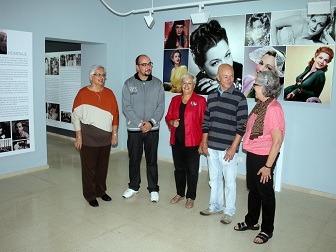
Foto de la inauguración de la exposición de María Montez, con la presencia del Sr. Alcalde Yeray Rodríguez, y de dos primas segundas de María Montez, Pilar García Pombrol y Pilar Cabrera Pombrol. Garafía, octubre de 2012. Del blog Garafia@s.
~*~ ~*~ ~*~
Fuentes consultadas:
Las raíces Turolenses de una diva (Heraldo, 26.10.2008)
Los Orígenes palmeros de la actriz María Montez (October/November 2009)
Personalidades Garafianas (12.2012)
La Exposición de María Montez viaja a Gran Canaria (El Apurón, 21.11.2013)
Dos Actrices Internacionales descendientes de un Luño (Plenas Zaragoza 14.12.2016)
Fotos del libro "María Montez La Reina del Tecnicolor", de Antonio Pérez Arnay (Filmoteca Canaria 1995) - Las fotos de este libro no están sujetas a ningún copyright.
#Gracia Family#Família Gracia#Joaquín Gracia Anadón#María Antónia García Martín#Isidoro Gracia García#María Montez#Armando Gracia San Fiel#Antonio Pérez Arnay#María Montez La Reina del Tecnicolor#Maria Montez#La Reina del Tecnicolor#The Queen of Technicolor#research#investigación#Maria Victoria Hernandez#Garafia#Barahona#ancestry#family history#genealogy#1930 Maria#2012 Maria
17 notes
·
View notes
Text
“PASEO DEL CINE DOWNTOWN” HONRA CON UNA ESTRELLA LA TRAYECTORIA DE ARCHIE LOPEZ, CHEDDY GARCIA, AGLIBERTO MELENDEZ Y MARIA MONTEZ
Santo Domingo D. N. En un evento abierto al público, el pasado miércoles 15, el grupo Caribbean Cinemas dejó develadas en su segundo año las estrellas del “Paseo del Cine Downtown”, donde fueron reconocidos: Archie López, Cheddy García, Agliberto Meléndez y la fenecida actriz reina del tecnicolor María Montez, representada por Dominic Fuentes. Este gran evento que se realiza con el fin de…
View On WordPress
0 notes
Text
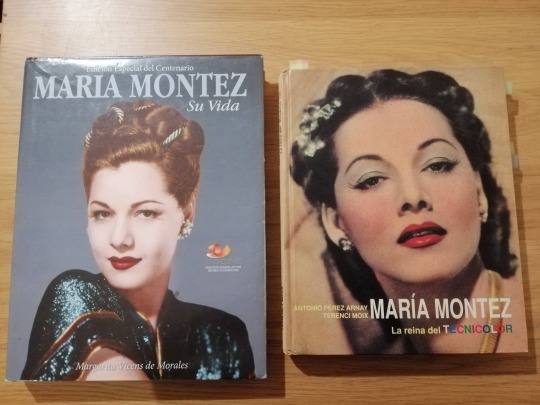



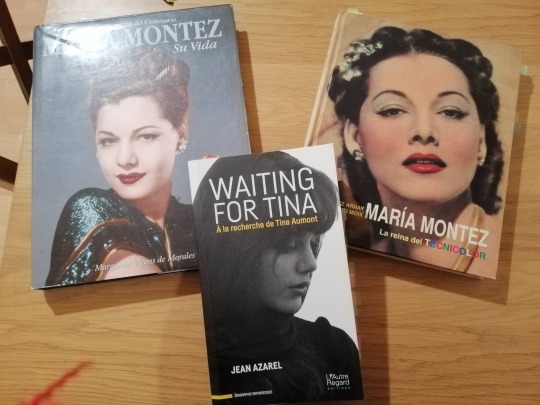
Books!
Hi everybody, at the begining of the year I purchased the two María Montez Books shown here, and I also have the biography of Tina Aumont that was published in 2019.
These books have wonderful photos of María, her family and Tina, and also have beautiful information of them.
I'm very happy to have them cause I will understand better these great big family.
@74paris told me that all Aumont, Villiers and Gracia/Montez descendants are still in touch, they really love eachother and they have a strong bond, even all their descendants are considered cousins among them, which is really beautiful keeping in mind that they are a one BIG family. In a youtube interview Dominic Fuentes said that once a year all the cousins meet so they don't lose any contact.
Although Marisa Pavan tried to separate them, love won because love was stronger, and even at her denial, Tina kept contact with her brothers Jean-Claude and Patrick and Jean-Claude helped her a lot and went with her at their father funeral.
Love always wins!
Eleni
xoxoxo
#María Montez#Maria Montez#Tina Aumont#books#María Montez Su Vida#Margarita Vicens de Morales#María Montez La Reina del Tecnicolor#António Pérez Arnay#Terenci Moix#Waiting for Tina#Waiting For Tina À la recherche de Tina Aumont#Jean Azarel#Aumont Family#Gracia Family#Montez Family#Villiers Family#love wins#love#strong bond#beautiful family#2024
17 notes
·
View notes
Text
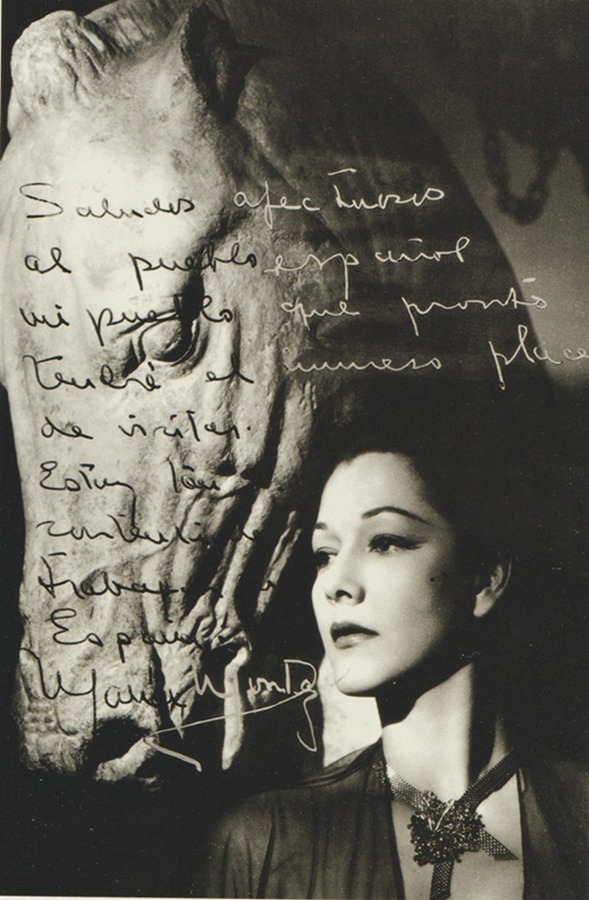
“Saludos afectuosos al pueblo español, mi pueblo, que pronto tendré el inmenso placer de visitar. Estoy tan contenta de trabajar en España! María Montez”
“Affectionate greetings to the Spanish people, my people, who I will soon have the immense pleasure of visiting. I am so happy to work in Spain! María Montez”
This is a postcard announcing that María would come to Spain to film “La Maja de Goya”, a film produced by Cesáreo González. He contacted her with the contract and the script and she agreed to take part on the film. The film was about to start by September 1951 but since 1949 the Spanish producer wanted to work with the Dominican Star.
Cesareo González was the one who promoted Mexican actress and singer María Félix and launched her career in European films. She first worked with him in "La Corona Negra" in 1951. This was a Spanish film co-produced by France and Italy.

[Mexican actress and singer María Félix pictured in 1947]
This photo was first printed in Spanish magazine Primer Plano number 560 from July 1951.

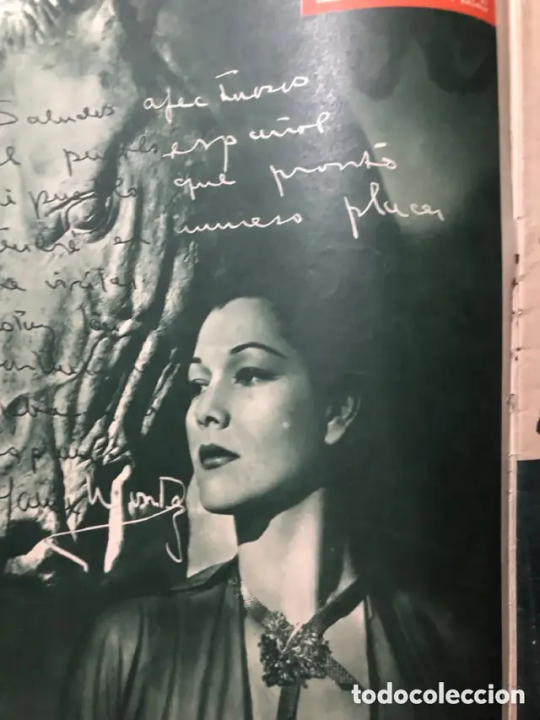
[Left: the magazine cover, featuring Ava Gardner, right the photo printed from the magazine]
Antonio Pérez Arnay had the magazine and was interested in getting the photo for his book "María Montez La Reina del Tecnicolor", and finally, he had a copy from the original one (believed to be in the Spanish Filmotheque) and could publish it in his great and unique book for María Montez.
Very special thanks to @74paris for the information given and the pics provided here.
#María Montez#Maria Montez#La Reina del Tecnicolor#The Queen of Technicolor#María Félix#1951#La Maja de Goya#Cesáreo González#Primer Plano#1951 Primer Plano#Spanish cinema#Spanish film#collaboration#Antonio Perez Arnay#María Montez la Reina del Tecnicolor#1951 Maria
10 notes
·
View notes
Text
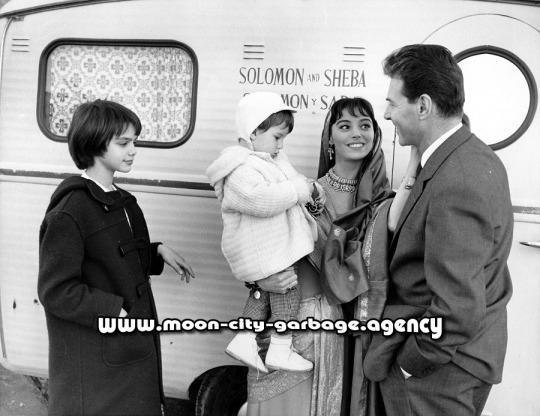
Litte Tina, aged 13 with her dad, step mother and half brother Jean-Claude Aumont in Madrid, Spain in 1959 while a break of "Solomon and Sheba" filming.
It's a beautiful thing that Tina visited Spain as a child and later filmed there "L'Uomo L'Orgoglio, la Vendetta" and "The Last Run" because she fulfilled her mother's dream in a way...
The thing is that María Montez wanted to film in Spain and she was about to do it in 1951, and she was really happy because she wanted to use her real surname Gracia (she changed it to Montez cause the English-speaking people don't know how to pronounce Gracia) and she wanted to do a film in Spanish, sadly, it never happened as fate had other plans for her...

"Saludos afectuosos al pueblo español, mi pueblo, que pronto tendré el inmenso placer de visitar. Estoy tan contenta de trabajar en España! María Montez"
"Affectionate greetings to the Spanish people, my people, who I will soon have the immense pleasure of visiting. I am so happy to work in Spain! María Montez"
This is a postcard announcing that María would come to Spain to film "La Maja de Goya", a film produced by Cesáreo González. He contacted her with the contract and the script and she agreed to take part on the film.
First photo comes from Moon City Garbage Agency and the second photo comes from "María Montez La Reina del Tecnicolor" book written by Antonio Pérez Arnay. Please notice that María is wearing a necklace that later inherited her younger sister Teresita and later she gave it to Tina, as you can see in this post.
Very special thanks to @74paris for his invaluable help!!
#Tina Aumont#María Montez#Maria Montez#Jean Pierre Aumont#Marisa Pavan#Jean Claude Aumont#1959#1951#La Maja de Goya#María Montez La Reina del Tecnicolor#Antonio Perez Arnay#Maria Montez necklace#Maria Montez jewels#Teresita Montez#1951 Maria
10 notes
·
View notes
Text
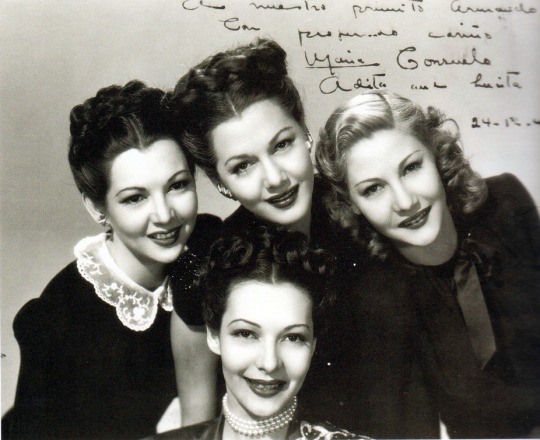
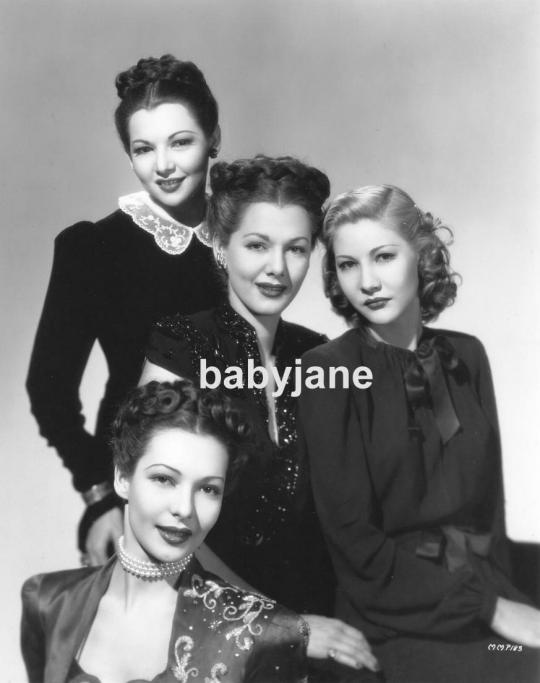
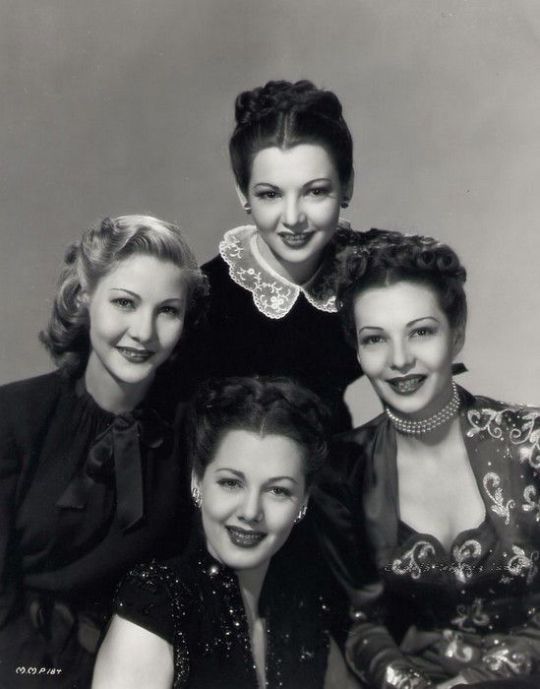
1944 Montez sisters
In 1944 upon their arrival in Hollywood, Maria younger sisters Consuelo, Adita and Lucita were received by her elder sister and under her wing they went to English private lessons and also to some social "etiquette" classes in order to have a very beautiful appeareance and to know how to behave in some places they weren't used to as they came from Dominican Republic rural area.
The photographer of these photos is unknown, but the first photo was sent from Maria to her Spanish cousin Armando Gracia Sanfiel (1913-1997) and he gave it to Antonio Perez Arnay (1959-2012) who published in his book "María Montez, La Reina del Technicolor" (Filmoteca Canaria, 1995).
The other photos come from ebay and pinterest.
#Maria Montez#María Montez#1944 María#Adita Gracia Vidal#1944 Adita#Lucita Gracia Vidal#1944 Lucita#Consuelo Gracia Vidal#1944 Consuelo#La Reina del Tecnicolor#the Queen of Technicolor#Antonio Perez Arnay#Armando Gracia Sanfiel#María Montez la Reina del tecnicolor#1944#A nuestro primito Armando
10 notes
·
View notes
Note
Hola Eleni!
Te cuento que anteayer le conté a mi hermana sobre María Montez y su vida y quedó sorprendida al saber su triste desenlace y que quedó en misterio su fallecimiento pero me dió una hipótesis o teoría; me dijo que al estar en la bañera pueda haber tocado algo de electricidad con el cuerpo mojado ya que María se bañaba con agua caliente y seguro quería calentarlo un poco más pero tristemente se pudo haberse electrocutado y fallecer en la bañera con la temperatura algo alzada fuera de lo normal.
Personalmente ahora que lo analizo puede que sea cierto porque cuando encontrarón el cuerpi de María, el agua estaba muy caliente y no a temperatura que María ponía normalmente.
Quería compartir esto porque me pareció raro el tema y jamás se le hizo autopsia.

Hola Andrea!
Muchas gracias por tu aporte, lo encuentro muy interesante. Cierto es que nunca se le hizo la autópsia a María Montez y no se sabe exactamente cómo murió.
Una teoría apunta a un paro cardíaco ya que el agua estaba muy caliente. Otra teoría apunta a que con el agua tan caliente, se desmayó y se ahogó.
Esta que te contó tu hermana me parece interesante y que también podría haber sido así, quien sabe si dejó el grifo abierto y el agua iba saliendo cada vez más caliente, en la mayoría de grifos pasa esto.
Es una pena, la teoría de tu hermana puede ser bien cierta, pienso que en ningún caso se suicidó. Hay algún libro y programa televisivo que así lo apunta, y no lo creo para nada, María era esclava de su belleza, pero tenía mucha vida y mucho amor por delante, estaba feliz con su vida personal y profesional, se iba a reencontrar con su família en República Dominicana, iba a filmar en España bajo su nombre real y en su idioma materno, quería hacer más teatro... la vida le sonreía...
Tantas veces he pensado que la vida de Tina y de toda la família hubiese sido tan diferente si María no hubiese muerto... es una pena.
Muchas gracias por preguntar y exponer tu teoría Andrea.
Te mando muchos besitos!!
Eleni ❤️❤️❤️
#Maria Montez#María Montez#actress#La Reina del Tecnicolor#The Queen of Technicolor#Dominican actress#Dominican Dynamite#Tempestuous Montez#The Siren of Hollywood#Old Hollywood beauty#ask#ask me#ask me anyhting#Gracia Family#Montez Family
14 notes
·
View notes
Text


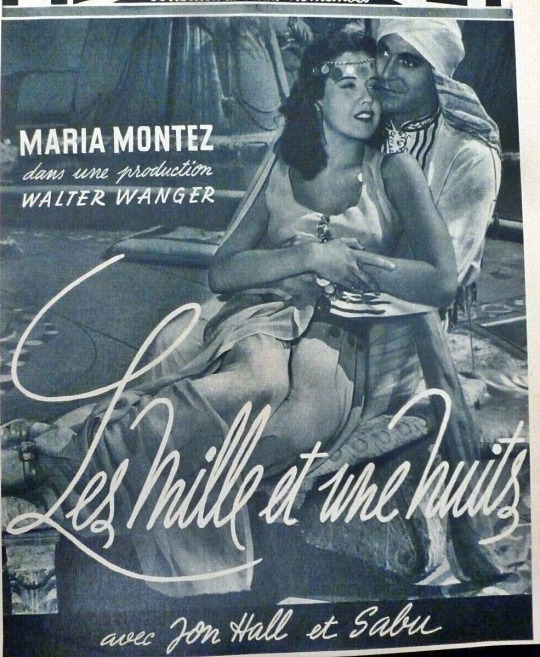


Arabian Nights
Arabian Nights is a 1942 adventure film directed by John Rawlins and starring Jon Hall, Maria Montez, Sabu and Leif Erikson. The film is derived from The Book of One Thousand and One Nights but owes more to the imagination of Universal Pictures than the original Arabian stories. Unlike other films in the genre (The Thief of Bagdad), it features no monsters or supernatural elements.
This is the first feature film that Universal made using the three-strip Technicolor film process, although producer Walter Wanger had worked on two earlier Technicolor films for other studios: The Trail of the Lonesome Pine (1936) at Paramount and the 1937 Walter Wanger's Vogues of 1938 for United Artists.
Plot (it may contain spoilers)
In ancient Persia, the young women of a royal harem read the story of Sherazade, unfolding the film's story. Sherazade, a dancer in a wandering circus, captures the attention of Kamar, the brother of the caliph, Haroun al-Rashid. Kamar's infatuation influences his attempts to seize the throne from Haroun and make Sherazade his queen. His revolt fails, and he is sentenced to slow death by exposure, but Kamar's men storm the palace and free their leader. Wounded and forced to flee, Haroun chances upon Sherazade's circus and is spotted by the young acrobat Ali Ben Ali. Aware of Haroun's identity, Ali hides him in the circus. Later, upon awakening from his injuries, Haroun beholds Sherazade and falls in love with her.
Meanwhile, Kamar assumes the throne, but Sherazade is not to be found. He orders the captain of his guard to find her, but a scheming grand vizier, Nadan, approaches the captain with the order to make Sherazade 'disappear.' After finding them, the captain sells the troupe into slavery. When the captain is found out, Nadan murders him in order to conceal his treachery. Haroun, Sherazade, and the acrobats escape the slave pens, but are found by Kamar's army and taken to a tent city in the desert. Kamar reunites with Sherazade and proposes, but she has fallen in love with Haroun instead. Nadan, recognizing the caliph, uses this knowledge to blackmail Sherazade into helping him remove Kamar from the throne, in return for safe conduct for Haroun out of the caliphate. In secret, however, he plans to have Haroun killed once he has crossed the border.
Upon learning of this insidious scheme, Ali and his fellow performers rescue Haroun, who then decides to free Sherazade with the help of the acrobats. But Haroun and the others are quickly captured, and Sherazade finally learns his true identity. Kamar engages Haroun in a swordfight, while the acrobats set fire to the tents; and the arrival of the caliph's loyal troops, summoned by Ali, triggers a massive battle. In the end, as Kamar prepares to deliver the deathstroke to Haroun, Nadan assassinates Kamar. But as he prepares to do in Haroun, Ahmad and Ali interfere, forcing him to flee. Nadan is stopped by a thrown spear and dies inside a burning tent, leaving Haroun, Sherazade, and their loyal friends to celebrate victory.
Cast
Jon Hall – Haroun-Al-Raschid
Maria Montez – Sherazade
Sabu – Ali Ben Ali
Leif Erikson – Kamar
Billy Gilbert – Ahmad
Edgar Barrier – Nadan
Richard Lane – Corporal
Turhan Bey – Captain of the Guard
John Qualen – Aladdin
Shemp Howard – Sinbad
William 'Wee Willie' Davis – Valda
Thomas Gomez – Hakim
Jeni Le Gon – Dresser / Dancer's Maid
Robert Greig – Eunuch
Charles Coleman – Eunuch
Emory Parnell – Harem Sentry
Harry Cording – Blacksmith
Robin Raymond – Slave Girl
Carmen D'Antonio – Harem Girl
The film was released on 25th December 1942.
Photos from ebay and text from wikipedia.
#Maria Montez#María Montez#1942#1942 Maria#Arabian Nights#1942 Arabian Nights#John Rawlings#John Hall#Sabu#Leif Erikson#Turham Bey#actress#La Reina del Tecnicolor#The Queen of technicolor#Montez Family#Gracia Family#Universal Pictures
16 notes
·
View notes
Text

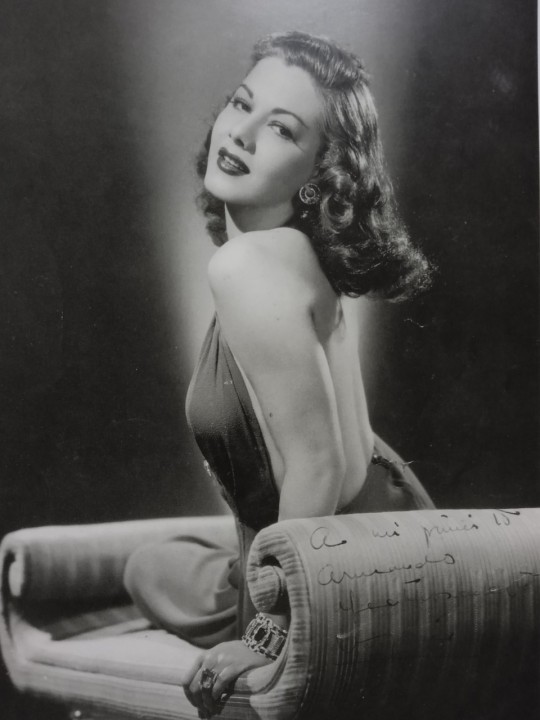

Beautiful photos of María Montez and her sisters.
These photos come from the personal archive of Armando Gracia Sanfiel who gave them to Antonio Perez Arnay who published them in the biographical book of María Montez "La Reina del Tecnicolor" (Editorial Filmoteca Canaria, 1995).
Armando Gracia Sanfiel was Aquilino Gracia García's son, and Aquilino was María's uncle (her dad's brother), so Armando was María's cousin.
María sent these three photos to her cousin Armando as they kept contact through letters, Armando was living in Madrid and he didn't know anything about María's private life or from his Dominican family, he just knew from his uncle Isidoro and from his family from La Palma and Teruel.
María and her cousin Armando first reached contact when he sent her a letter when she was living in Hollywood telling her he was her cousin as their dads were brothers and from that day María started sending him letters with photos and she was really interested about her family in Spain and asked him lots of questions about them.
Very special thanks to @74paris for sending me these photos and the information that comes with them.
#María Montez#Armando Gracia Sanfiel#Aquilino Gracia García#Gracia Family#La Reina del Technicolor#1995 La Reina del Tecnicolor#Antonio Perez Arnay#Terenci Moix#Adita Gracia Vidal#Consuelo Gracia Vidal#Lucita Gracia Vidal#collaboration#A nuestro primito Armando#Montez Family
16 notes
·
View notes
Text

Adita, Lucita, María and Consuelo pictured in 1944 for the Universal Pictures.
Very special thanks to @74paris for sending me this gem ✨
#Adita Gracia Vidal#1944 Adita#Lucita Gracia Vidal#1944 Lucita#Maria Montez#María Montez#1944 María#Consuelo Gracia Vidal#1944 Consuelo#Universal Pictures#actress#La Reina del Tecnicolor#the Queen of Technicolor#Montez sisters#Gracia sisters#Montez Family#Gracia Family#collaboration
11 notes
·
View notes
Text

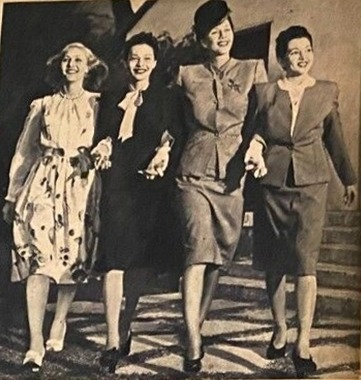



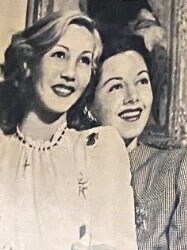
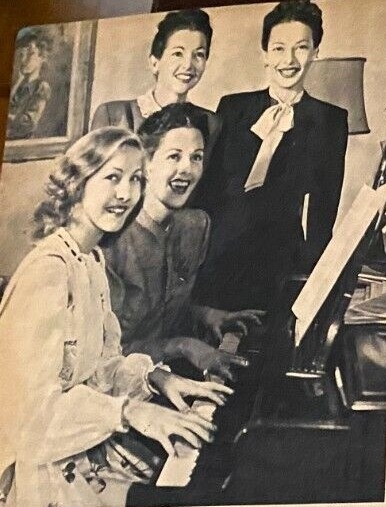
Two page spread in a US magazine from 1944 about the arriving in Hollywood of María's younger sisters Adita, aged 19; Consuelo, aged 18 & Lucita aged 17 (according to the magazine).
The beautiful sisters had lots of good times together singing the old folk song mother taught them and even making some fortune tellings by reading the cards!
Ebay.
#1944#Maria Montez#María Montez#1944 María#Consuelo Gracia Vidal#1944 Consuelo#Adita Gracia Vidal#1944 Adita#Lucita Gracia Vidal#1944 Lucita#clipping#1944 clipping#Montez Sisters#Gracia Sisters#Gracia Family#Montez Family#La Reina del Tecnicolor#The Queen of Technicolor#actress
11 notes
·
View notes
Text
Maria Montez screentest for "Blood and Sand".
This film was released in 1941 starring Tyrone Power, Linda Darnell, Rita Hayworth and Nazimova.
Maria Montez was making this screentest for "Doña Sol" character that later got Rita Hayworth.
Very special thanks to @74paris for sharing this video from youtube.
#Maria Montez#María Montez#actress#model#1940 Maria#1941 Maria#Blood and Sand#Blood and Sand screen test#screen test#collaboration#La Reina del Tecnicolor#The Queen of Technicolor#Gracia Family#Montez Family
8 notes
·
View notes
Text
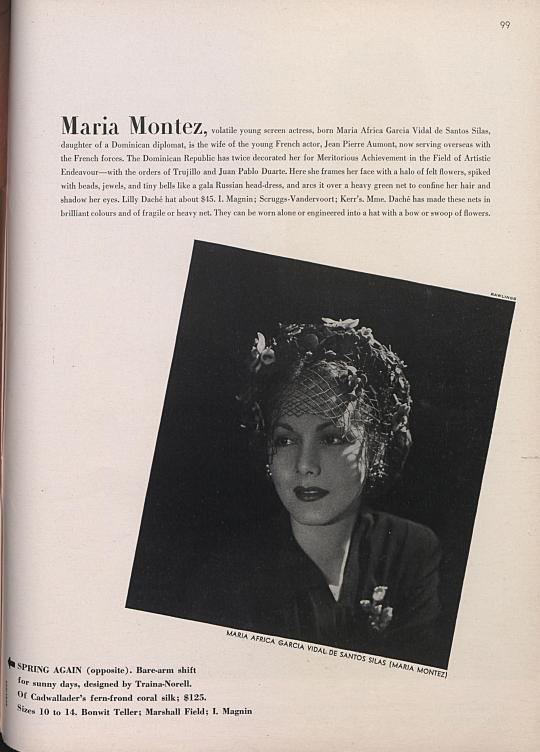
María Montez photo published at US Vogue, 1st April 1944.
Photo taken by Rawlings.
From The Fashion Spot forums.
#María Montez#Maria Montez#1944 María#actress#model#The Queen of Technicolor#La Reina del tecnicolor#Vogue#US Vogue#1944 Vogue#1944 US Vogue#Vintage Vogue#Rawlings#1944 Rawlings#Montez Family#Gracia Family
7 notes
·
View notes
Text


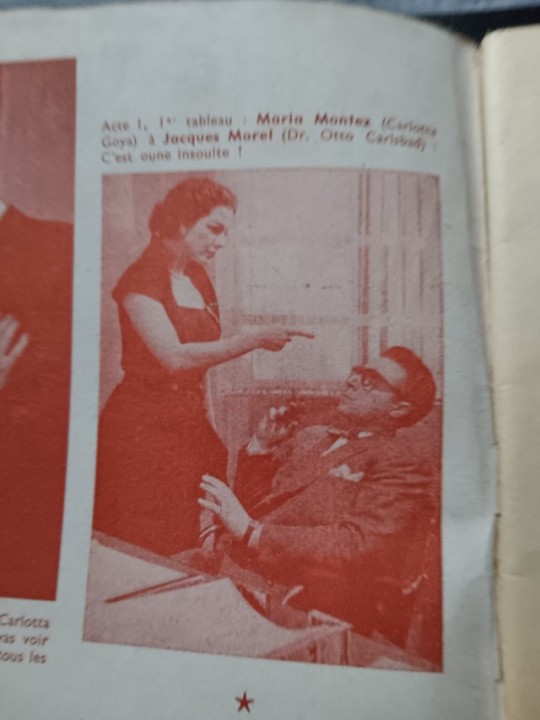
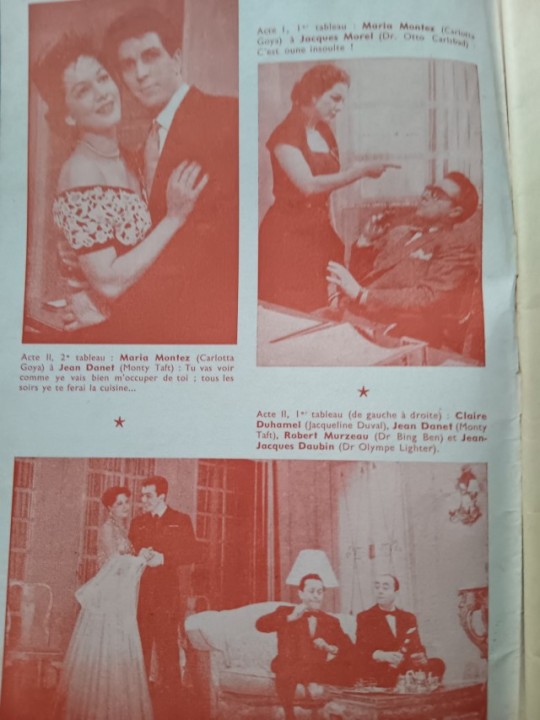
L'île Heureuse (1951)
L'Île Heureuse was a theatre play written by Jean-Pierre Aumont who wrote it for María Montez, it was directed and performed by Pierre Dux and María Montez and it was shown for the first time at Edouard VII Theater in Paris on January 24, 1951.
The play was a success, the actors made a well performance and María Montez received very beautiful acclaims from the critics.
This was the first of many theatre performances at théâtre Édouard-VII and then the play travelled to some other French cities always having great acclaim from the public and the critics, this fact made María got real interest in doing more stage plays.
Maria Montez plays the 25-year-old Spanish dancer Carlota Goya.
Very special thanks to @74paris for sharing this program.
#María Montez#Maria Montez#1951 Maria#L'île Heureuse#1951 L'Île Heureuse#Jean Pierre Aumont#Jean Danet#Pierre Dux#Jacques Morel#stage actress#actress#Queen of Technicolor#La Reina del Tecnicolor#collaboraion
8 notes
·
View notes
Text

Bervely Hills, el 14 de noviembre de 1944
Querido primo Armando:
Con inmenso placer recibí hace tres días tu cariñosa cartita y tu foto y la foto del primo Isidoro que tanto se parece al pobre tío Joaquín (q. e. p. e.).
Tu carta y tu retrato estaban esperando en casa, pues yo estaba en Nueva York adonde fui a hacer una aparición en la Radio y al mismo tiempo ir a buscar a mis hermanas Ada, Consuelo y Lucita las cuales están como yo contentísimas de encontrarse con un primito tan simpático y elegante.
Yo enseguida que recibí tu primera carta le escribí a mis hermanos y al primo Aquilino para que se pusieran en contacto contigo.
Gracias por el recorte de periódico que me mandaste, eres muy gentil y tengo muchos deseos de conocerte personalmente, tal vez te das un viajecito por estos lares o te veré cuando yo vaya por allá que será tan pronto se acabe esta maldita guerra.
En sobre separado te enviamos las muchachas y yo varias fotos de nosotras, para que tú veas cómo en realidad son tus primitas de América.
Te agradecería infinito si me das la dirección del resto de la familia —de mi prima Australia y los hijos de tía Tomasa la cual me dijo Aquilino el primo, está muerta, ¡la pobre!— ¿Cuántos hijos dejó Tomasa? ¿y Gaudencia?
¿Y están aún vivos los tíos de papá?
¿Cuántos hermanos son usdes.?
¿Adónde están el resto?
¿Y hace mucho tiempo que están en Madrid?
Pásame la dirección del primo Isidoro —desearía escribirle a él también y enviarle unas fotos.
Nosotros somos diez, ¡sí, diez! Cinco hembras y cinco varones. Mamá se mudó a la capital que se llama: Trujillo City y queda sólo cuatro horas de Barahona adonde nacimos nosotros —allá con mamá están todos los hermanos, y la pequeñita que sólo tiene 12 años y se llama Teresita —y es lindísima—, mi hermano Isidorito que es el mayor está con mamá y es un señorito muy simpático pero holgazán, mi hermano Aquilino es el jefe de la familia y el encargado de nuestros negocios que es una plantación y negocios de madera los cuales importamos a Inglaterra y Estados Unidos y en tiempo de paz a Alemania y Holanda, Joaquín está aún en la escuela, lo mismo Luis y Jaime, que acaban de entrar en cursos teóricos —Luis se parece algo a tu foto, y Jaime es muy rubio. Aquilino se parece a papá y es muy alto y guapo. Teresita está también en un colegio, mejor debo decir, convento, muy buena estudiante y habla ya el inglés bastante bien.
Ada, Consuelo y Lucita, las cuales puedes ver en las fotos cómo son, se van a quedar aquí conmigo y tratan de hacer carrera —Lucita quiere ser artista de cine y Consuelo modista diseñadora de trajes y sombreros, y Adita no quiere hacer nada, sólo casarse con un millonario, lo cual no es mala carrera, ¿eh? Pero yo no la fuerzo a hacer nada, ella ya verá cómo le gusta la vida sin trabajar, lo cual aquí es muy difícil de sobrellevar. Aquí todo el mundo trabaja, es un vicio.
Tan pronto se acabe la guerra, mamá piensa ir a vivir a España, tal vez en Barcelona o Teruel y se lleva allá a Luis, Jaime y Teresita y formar hogar adonde está nuestra familia, pues en Santo Domingo no tenemos nosotros a nadie, sólo el primo Aquilino.
Espero, pues, hayas ya visto «Arabian Nights» que fué la primera película estelar que yo hice de importancia, después de ésta hice: White Savage que creo la llaman La Blanca Salvaje ó «La reina de la Selva», «La Mujer Cobra», «Ali Babá», «Alma Gitana” (Gipsy Wildcat), y una en trajes modernos llamada «Bowery to Broadway» (no sé cómo la llamarán en español) y mi último film llamado «La Reina del Nilo», la cual es muy bonita película y de un tecnicolor precioso. Aún no sé cuál será mi próxima.
Ésta es una carta enorme y llena de información, ¿verdad?
Cariñosos abrazos a Isidoro y la demás familia.
Ada, Consuelo y Lucita te envían sus afectuosos saludos.
Cariñosamente, tu prima.
María
~*~*~*~
Beverly Hills, November 14, 1944
Dear cousin Armando:
With immense pleasure I received three days ago your affectionate little letter and your photo and the photo of cousin Isidoro who looks so much like poor uncle Joaquín (r.i.p.).
Your letter and your portrait were waiting at home, because I was in New York where I went to make an appearance on the Radio and at the same time go look for my sisters Ada, Consuelo and Lucita who, like me, are very happy to meet with such a nice and elegant cousin.
As soon as I received your first letter, I wrote to my brothers and cousin Aquilino to get in touch with you.
Thank you for the newspaper clipping you sent me, you are very kind and I really want to meet you personally, maybe you will take a little trip around these parts or I will see you when I go there, which will be as soon as this damn war is over.
In a separate envelope, the girls and I sent you several photos of us, so that you can see what your little cousins from America really look like.
I would be extremely grateful if you would give me the address of the rest of the family—my cousin Australia and Aunt Tomasa's children, whom Aquilino, the cousin, told me is dead, poor thing!—How many children did Tomasa leave behind? And Gaudencia?
And are Dad's uncles still alive?
How many brothers are you?
Where are the rest?
And have they been in Madrid for a long time?
Give me cousin Isidoro's address—I would like to write to him too and send him some photos.
We are ten, yes, ten! Five females and five males. Mom moved to the capital called: Trujillo City and it is only four hours from Barahona where we were born - all the siblings are there with Mom, and the little one who is only 12 years old and her name is Teresita - and she is very cute - my Brother Isidorito, who is the eldest, is with mother and is a very nice but lazy young man. My brother Aquilino is the head of the family and in charge of our business, which is a plantation and wood business which we import to England and the United States. in peacetime to Germany and Holland, Joaquín is still in school, as are Luis and Jaime, who have just started theoretical courses —Luis looks something like your photo, and Jaime is very blonde. Aquilino looks like dad and is very tall and handsome. Teresita is also in a school, I should say, a convent, a very good student and she already speaks English quite well.
Ada, Consuelo and Lucita, who you can see in the photos what they are like, are going to stay here with me and try to make a career - Lucita wants to be a film artist and Consuelo a dressmaker, a designer of suits and hats, and Adita doesn't want to do anything, just marry a millionaire, which isn't a bad career, eh? But I don't force her to do anything, she will see how she likes life without working, which is very difficult to cope with here. Here everyone works, it's a vice.
As soon as the war is over, Mom plans to go live in Spain, perhaps in Barcelona or Teruel and she will take Luis, Jaime and Teresita there and make a home where our family is, because in Santo Domingo we have no one, only cousin Aquilino.
I hope, then, that you have already seen "Arabian Nights" which was the first major star film that I made, after this I made: "White Savage", which I think they call "The Wild White" or "The Queen of the Jungle", "Cobra Woman", «Ali Baba», «Alma Gitana» (Gipsy Wildcat), and one in modern costumes called «Bowery to Broadway» (I don't know what they will call it in Spanish) and my latest film called «The Queen of the Nile», which It is a very beautiful film and a beautiful technicolor. I still don't know what my next one will be.
This is a huge letter full of information, right?
Affectionate hugs to Isidoro and the rest of the family.
Ada, Consuelo and Lucita send you their affectionate greetings.
Kindly, your cousin.
Maria
~*~*~*~
First of some letters that are going to be published here just to know a little bit more about Maria, her family and her relationship she had with his cousin Armando Gracia Sanfiel.
This transcription is possible thanks to @74paris who sent me a document called "Los orígenes turolenses y canarios de la actriz de Hollywood María Montez" written by María Victória Hernández Pérez, courtesy of Cabildo de la Palma.
#A nuestro primito Armando#Armando Gracia Sanfiel#letter to Armando#Maria Montez#María Montez#Los orígenes turolenses y canarios de la actriz de Hollywood María Montez#María Victória Hernández Pérez#Cabildo de la Palma#Gracia Family#The Queen of technicolor#La Reina del Tecnicolor#actress#1944#1944 Maria#collaboration
7 notes
·
View notes
Text
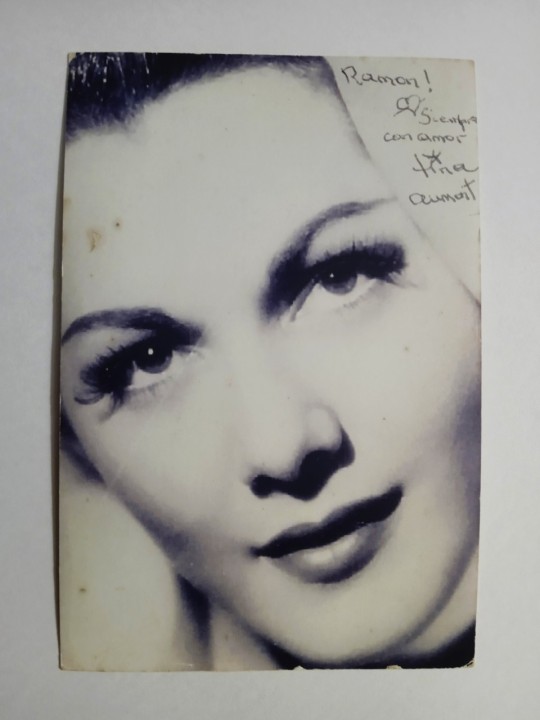
Beautiful María Montez photo that Tina gave to Ramón.
Very special thanks to @74paris for sharing this photo.
#Tina Aumont#2000s events candids#María Montez#Maria Montez#Queen of Technicolor#La Reina del Tecnicolor#actress#Old Hollywood#Gold Hollywood#meeting Tina#collaboration#beautiful actress#glamorous actress#black and white portrait#assorted Maria
31 notes
·
View notes